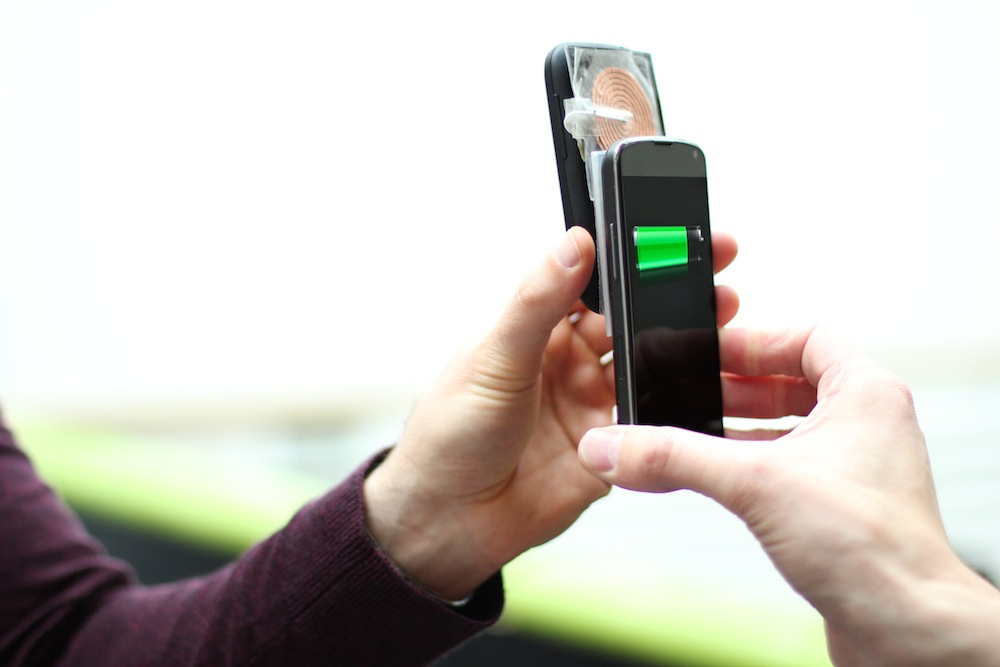
Low Battery? New Tech Lets You Wirelessly Share Power

It's any phone-obsessed person's nightmare: you're out, your phone's battery is depleted down into the red zone, and there's not an electrical plug in sight. But one day, mobile and wearable devices could engage in "power-sharing," by wirelessly charging each other on the go, researchers say.
This innovative solution could help people easily recharge mobile or wearable gadgets, particularly for tasks such as emergency phone calls, the scientists added.
Mobile and wearable devices are now virtually everywhere, but their battery lives remain limited, with many lasting for less than a day. [Top 10 Inventions that Changed the World]
A number of devices now exist to provide extra power to mobiles and wearables, such as power packs, mobile hand generators and solar cells. But although external power packs have become popular, they add size and weight, and mobile hand generators and solar cells produce only limited amounts of power.
Instead, an invention called PowerShake allows mobile and wearable devices to wirelessly charge other mobile and wearable devices on the go, even when those devices are being held or worn. Wireless-charging technologies are becoming more prevalent, but many of these stations are fixed, and do not account for devices near or in contact with skin.
"When mobile phones first came out, people really found them liberating because they didn't have to be attached to a wire, but they actually still do have to be attached to a wire when they recharge," said study co-authorMike Fraser, a computer scientist at the University of Bristol in England. "So now we're seeking to liberate mobile phones again, to help them manage power without plugging in."
Wireless charging involves at least two coils — one in the power transmitter, and one in the power receiver. When an electric current passes through the power transmitter coil, it creates an electromagnetic field that can transfer charge to another coil. Power transmission is best at close distances, the scientists said.
Get the world’s most fascinating discoveries delivered straight to your inbox.
The researchers experimented with a variety of power transmitter and receiver coils. They also devised electromagnetic shielding made of ferrite plates and copper tape on the back of coils in order to prevent any transmitted energy from reaching human tissue. They noted flexible coils were also possible, and potentially embeddable in watch straps.
In experiments, PowerShake fit into small devices, met wireless power transfer safety guidelines, and performed about as well at power transmission as commercial alternatives, such as the Qi wireless charging pad, transferring about 3.1 watts of power, the researchers said. They estimated that about 12 seconds of charging would support 1 minute of additional talk time, while 2 minutes of charging would support about 4 minutes of video watching.
One drawback of PowerShake is that twice as much energy needs to be transmitted as is received.
"The power transfer is not ever going to be cost-free," Fraser told Live Science. "That's just the intrinsic power cost of wireless charging in general — wireless charging is always going to consume more power than wired charging."
In workshops, the researchers found that volunteers exploring the potential usefulness of PowerShake liked the idea of sharing power with their friends or family. However, due to the power costs of PowerShake, volunteers noted that if they needed to make an emergency call, they would probably just ask to borrow a phone instead of asking for power. Still, "if one needs to complete something on a particular device, and have already started but are running out of power halfway through and can't switch devices, this could help people," Fraser said.
The researchers now seek to have volunteers test PowerShake in real environments, "to see if it actually works, and if people do find it useful," Fraser said.
The scientists detailed their findings May 11 at the annual CHI conference on human-computer interactions in San Jose, California.
Follow us @livescience, Facebook & Google+. Original article on Live Science.

